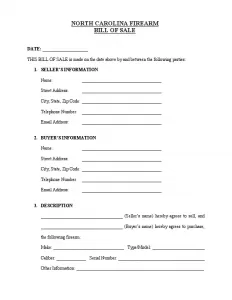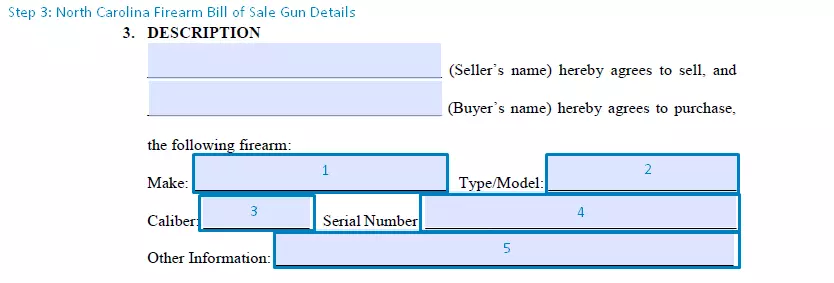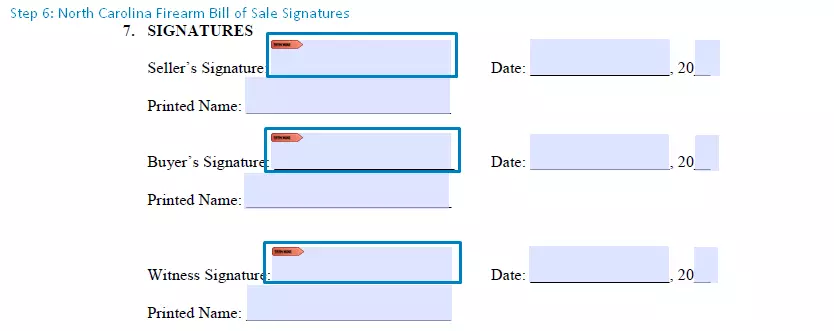North Carolina Firearm Bill of Sale Form
When you purchase a firearm in North Carolina, ensure that you use a gun bill of sale to finalize the transaction. North Carolina recognizes it as a legal document that individuals can use to prove ownership after the sale. It provides a detailed description of the firearm, purchase cost, names of the buyer and seller, witnesses, signatures, and other relevant information regarding the sale.
The bill of sale form protects both parties from illegal transactions. For instance, the purchaser will know the origin of the firearm and will not buy it from a criminal unknowingly and the seller will not be liable for any crimes committed with the gun after the legal sale. More details that you might need to understand the essence of the document are provided in our guide to using bills of sale.
When both parties reach a consensus, they have to sign the bill of sale in the presence of notary representatives as proof of ownership transfer and get a CCW licensing (concealed weapons permit).
North Carolina bill of sale templates – consider other bills of sale used in the State of North Carolina.
Registering a Firearm in North Carolina
Most states do not require gun registration after completing the purchase. North Carolina is not an exception since there are no firearm registration laws for individuals who purchase guns for personal reasons. Thus, you don’t have to register your firearm after purchase as long as you have a gun license.
However, North Carolina holds a strict position regarding firearm possession. An individual cannot just walk into a firearm dealer shop and buy a gun. Each county has a unique law that governs the sale of firearms. County sheriffs have the mandate to offer individuals a gun permit after conducting a thorough background check. In some instances, the Sheriff will interview other people in your community to find out your moral character. If you have a criminal record, you may not get one, or you may have to wait longer to get a permit.
If you want to purchase a firearm or concealed weapon license, the State of North Carolina recommends that you read the Firearm Gun Laws Manual before making any payments. Find out all the requirements that your county needs to process the license, or you can visit your local Sheriff to find out more information. You need to take into account all the specifics of a transaction involving a firearm – click for more details.
Below are the particulars to be included in the bill of sale template:
- Full names of the buyer and seller
- Driver’s license number of the buyer and seller
- City and state
- Physical address
- Firearm description: the make, model, serial number and caliber
- Purchase price
- Date of the sale
- Names and signatures of the buyer, seller, and two witnesses
- Notary information
In a firearm sale, all parties involved must sign the document in the presence of a lawyer or legal representative. After the seller, buyer, and witnesses agree and sign the document; the notary public will imprint a seal on the sale form.
The seller then ensures that the parties get copies of the sale form for record-keeping purposes while the buyer stays with the original copy.
North Carolina Firearm Purchase Details
| Subject | Long Guns | Hand Guns |
| Registration of a Firearm | Not required | Not required |
| Permit to Purchase | Not required | Required |
| Concealed Weapons Permit Fee | $90 | |
| Background Check for Private Sales | Not required | Required |
| Persons Prohibited from Carrying Firearms | North Carolina General Statutes, Sections 14-415.11 and 14-415.13 | |

How to write North Carolina Firearm Bill of Sale
The completing advice was written for the bill of sale template created by our team. Nevertheless, if there’s a form provided by your local officials, it’s advised to choose it during the transaction.
Step 1: Specify the date when document is created.

Step 2: Provide the buyer’s and seller’s information:
- Full legal name
- Address: Street, City, State of residence, Zipcode
- Contact information: Mobile phone number, Email address

Step 3: Fill out the detailed information concerning the firearm you’re selling:
-
- Manufacturer
- Type/Model
- Caliber
- Serial Number
- Other information you deem crucial.

Step 4: Choose how the buyer will pay for the car and for what amount.
This step also involves specifying the exact date of the purchase and the overall sum decided upon by all parties of the deal. You will need to also mark the selling method the buyer will go for:
- The full amount straight away. One of the hassle-free methods: on the same day, the purchaser gets the firearm delivered to them and pays off the whole amount.
- Trade-in. In case this option is picked, the selling party trades their firearm for the firearm presented by the buyer. If the buyer’s firearm is lower in value, they’ll need to even that out with an additional payment. In such a case, the document should also have the purchaser’s firearm specifics.
- In installments. Enter the downpayment sum plus the exact date it should be paid, together with the date by which the total sum has to be transferred to the seller.
Your next step is selecting the kind of payment:
- Cash
- Cheque
- Cashier’s check
- Money order
The last thing to do in this part would be to determine whether all applicable taxes are included in the final cost.

Step 5: Go through standard disclosures and provisions and make sure that both parties are familiar with them.
Both parties must agree with needed disclosures by placing their signatures under every list correspondingly. The “as-is” part indicates that the seller gives no warranties and is not responsible for repairs after the transaction.

Step 6: Put your signature(s) in the corresponding fields.
In most states, the signature of the buyer isn’t necessary. However, you will end up more protected against legal problems if both sides sign the bill of sale form. You could additionally have one or a few witnesses confirm the deal.

Step 7: Use the assistance of a notary public
Notarization is generally not required, but it’s an effective approach to create another layer of legal protection to your agreement.
The buyer will need to own the original bill of sale since it is frequently required for the title change. As a seller, you could either create a copy and keep it or have two identical forms signed and filled out by both sides.
